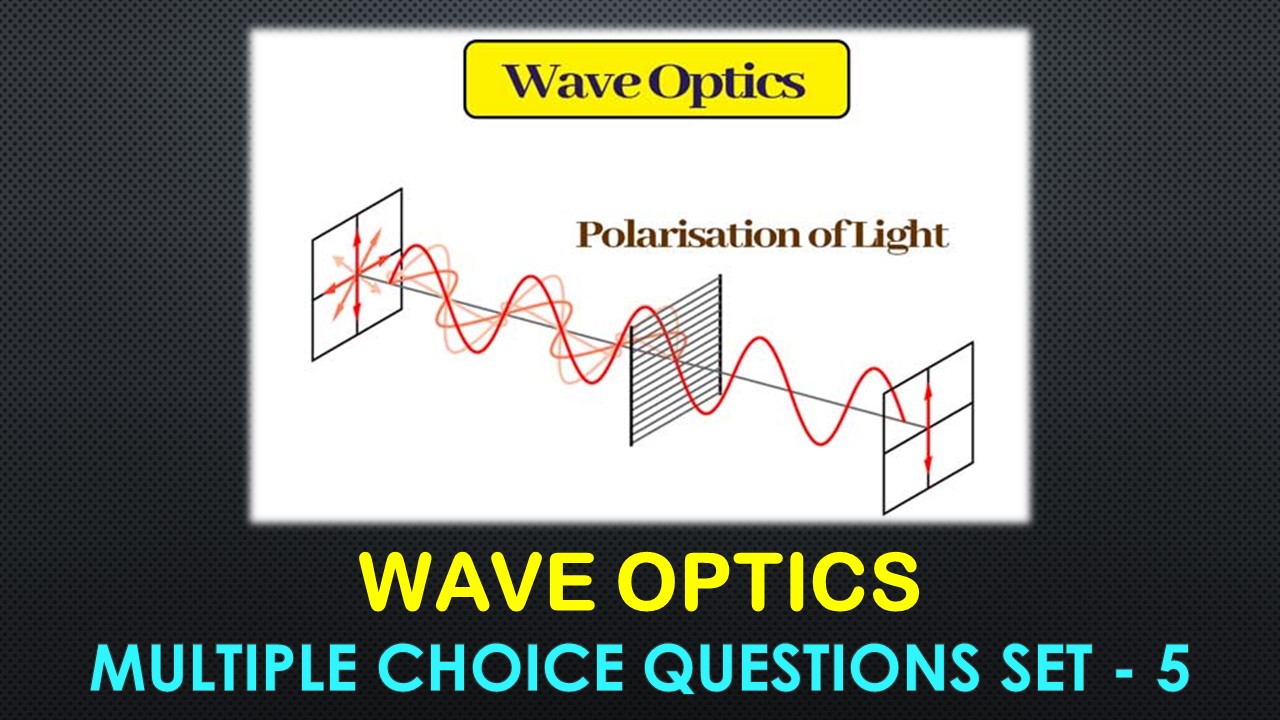CBSE Class 12 Wave Optics Multiple Choice Questions with Answers. MCQ Questions Class 12 Wave Optics with Answers Is Prepared Based on Latest Exam Pattern. Students can solve NCERT Class 12 Wave Optics MCQs with Answers to know their preparation level.
Students who are searching for NCERT MCQ Questions for Class 12 Wave Optics with Answers are compiled here to get good practice on all fundamentals. Know your preparation level on MCQ Questions for Class 12 Wave Optics with Answers. You can also verify your answers from our provided MCQ Class 12 Wave Optics with Answers. So, ace up your preparation with MCQ of Class 12 Physics Examinations.
MCQ Questions Class 12 Wave Optics with Answers - Set - 5
Question 1:
Out of the following Statements which is not correct?
(a) When unpolarised light passes through Nicol’s prism, the emergent light is elliptically polarized
(b) Nicol’s prism works on the principle of double refraction and T.l.R.
(c) Nicol’s prism can be used both the produce and analyse polarized light
(d) Calcite and Quartz are both double refracting crystal
Correct Answer – (A)
Question 2 :
The minimum value of the refractive index is:
(a) zero
(b) 1
(c) less than 1 but not zero
(d) more than 1
Correct Answer – (C)
Question 3 :
In Young double slit experiment, a minimum is obtained when the phase difference of the superposing waves, is (n ∈ l):
(a) nπ
(b) (n + ½)π
(c) (2n + 1)π
(d) Zero
Correct Answer – (C)
Question 4 :
The application of Doppler effect are:
(a) Doppler spectrometer
(b) Doppler radius
(c) Doppler velocimeter
(d) All of these
Correct Answer – (D)
Question 5 :
Poisson’s bright spot was discovered by:
(a) Fresnel
(b) Rayleigh
(c) Poisson
(d) Fraunhoffer
Correct Answer – (C)
MCQ Questions Class 12 Wave Optics with Answers
Question 6 :
Polarization of light prove the :
(a) corpuscular nature of light
(b) quantum nature of light
(c) Transverse wave nature of light
(d) Longitudinal wave nature of light
Correct Answer – (C)
Question 7 :
The angle of minimum deviation of a prism depends upon the aggie of:
(a) incidence
(b) reflection
(c) prism
(d) none of these
Correct Answer – (C)
Question 8 :
Which of the following is conserved when light waves interefere?
(a) phase
(b) intensity
(c) amplitude
(d) none of these
Correct Answer – (D)
Question 9 :
The theory of expanding universe is confirmed by the observation of the spectral lines of the star, which shows :
(a) green shift
(b) red shift
(c) violet shift
(d) yellow shift
Correct Answer – (B)
Question 10 :
The intensity of light emerging from the two slits, in Young’s experiment is in the ratio 1 : 4. The ratio of,the intensity of the minimum to that of the consecutive maximum will be:
(a) 1 : 4
(b) 1 : 9
(c) 1 : 16
(d) 2 : 3
Correct Answer – (B)
- NCERT Solutions Class 11 Chemistry Chapter 1 : Some Basic Concepts of Chemistry
- NCERT Solutions Class 11 Chemistry Chapter 2 : Structure Of The Atom
- NCERT Solutions Class 11 Chemistry Chapter 3 : Classification of Elements and Periodicity in Properties
- NCERT Solutions Class 11 Chemistry Chapter 4 : Chemical Bonding and Molecular Structure
- NCERT Solutions Class 11 Chemistry Chapter 5 : States of Matter
- NCERT Solutions Class 11 Chemistry Chapter 6 : Thermodynamics
- NCERT Solutions Class 11 Chemistry Chapter 7 : Equilibrium
- NCERT Solutions Class 11 Chemistry Chapter 8 : Redox Reactions
- NCERT Solutions Class 11 Chemistry Chapter 9 : Hydrogen
- NCERT Solutions Class 11 Chemistry Chapter 10 : The s-Block Elements
- NCERT Solutions Class 11 Chemistry Chapter 11 : The p-Block Elements
- NCERT Solutions Class 11 Chemistry Chapter 12 : Organic Chemistry: Some Basic Principles and Techniques
- NCERT Solutions Class 11 Chemistry Chapter 13 : Hydrocarbons
- NCERT Solutions Class 11 Chemistry Chapter 14 : Environmental Chemistry




